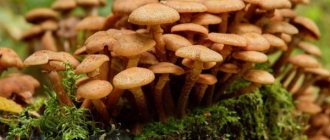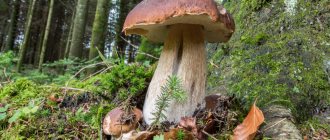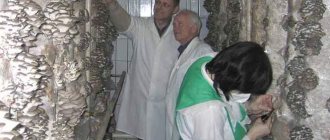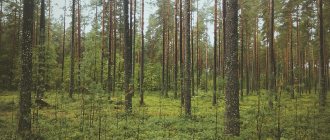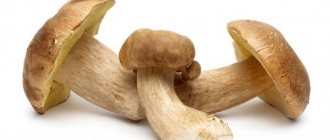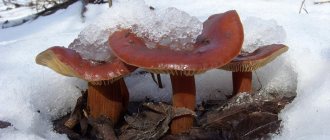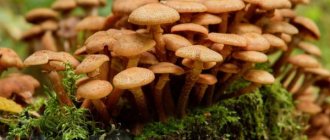However, porcini mushrooms only prefer certain places. Knowing this, you can be more likely to find these mushrooms. So let's find out where and in which forests do porcini mushrooms grow?.
in which forests do porcini mushrooms grow?
Where do porcini mushrooms grow?
Porcini mushrooms prefer to grow under old oak, birch and trees with pine needles. Boletus mushrooms can often be found close to lichens. At the same time, the color of the mushroom depends on the place of growth. For example, a porcini mushroom with a brown-gray cap grows under an oak tree, and its flesh is very loose (compared to the boletus mushroom that grows under a birch tree). But still, there is a much greater chance of finding a boletus under a pine or fir tree.
However, if there is moist soil nearby, such as a swamp or lake, then you are unlikely to come across porcini mushrooms there. The fact is that this representative of the mushroom kingdom prefers sandy or loamy soil. You can find it not only in the shade of a tree, but also in a field near lichens. Sometimes boletus mushrooms grow along highways, but it is better not to collect them, as they are poisoned by gases from cars.
What novice mushroom pickers should know
Unfortunately, many novice mushroom pickers confuse the white mushroom with the gall mushroom (another name for the false white mushroom). The fact is that this analogue is very similar to an edible mushroom. But at the same time, the gall fungus is inedible. Of course, you are unlikely to get poisoned from a small piece (you will definitely get poisoned from a large amount). But false porcini mushroom is characterized by a strong unpleasant taste, you will immediately understand that something is wrong. If you cook it with edible mushrooms, the entire batch can be disposed of immediately. Since all boletus mushrooms will acquire this unpleasant taste.
Mushroom picker calendar
Benefits of mushrooms
Boletus mushrooms are not only tasty, but also very healthy mushrooms. They contain vitamins A, D, B1, C, iron, calcium, selenium, riboflavin.
The last ingredient has a positive effect on the human immune system, improves the condition of the skin, hair and nail plates, and also helps the normal functioning of the thyroid gland. The components of boletus stimulate the secretion of digestive juices.
How porcini mushrooms grow
Mushroom pickers who prefer to go and pick mushrooms all season will be interested in how long it takes for a new mushroom to grow. This can be used as a starting point for the question of when porcini mushrooms grow. And if you already know where to look, then you can simply come every few days and collect a large number of boletus mushrooms. True, if many people know about this place, then such a plan will be difficult to implement. But that's not what we're talking about.
Per night
How long does it take for porcini mushroom to grow? If we talk about central Russia, then boletus mushrooms grow here in 6-10 days, depending on the recent weather. Please note that we are now talking about mushroom season. This means that the porcini mushroom practically does not grow overnight, if only just a little. Therefore, if you drive every day, you will only find small mushrooms that won’t even be used for frying.
Boletus mushrooms grow in 6-10 days
Per day
If there has been heavy rain recently, how quickly does the boletus grow? In this case, the mushroom may need 2-3 days. This means that the next day you can come to the mushroom field and find mushrooms that have grown, which were tiny just yesterday. But for cold regions of Russia this phenomenon is practically not typical. But for the South and the middle part - more than. Therefore, within a week after heavy rain, you can go mushroom hunting every 1-2 days.
During the week
Above we talked about how many days a porcini mushroom grows. In normal weather, the growth process lasts 6-10 days. And already in 3-4 weeks the mushroom deteriorates, so it is advisable to capture exactly this period. We will look at how to properly look for mushrooms in the article below. But it’s worth remembering that now almost all mushroom places are already familiar to local residents. This means you should take into account the risk that you may arrive at a clearing that has already been treated. So don't hesitate.
Species diversity and description
The porcini mushroom is considered the most valuable of all; it is very nutritious and tasty. That is why mushroom pickers are so eager to collect as much of this particular species as possible. Even in ancient times, people noticed that this mushroom does not turn black even after drying, its flesh remains white. That is why it received such a name.
Although it is not common in all areas. You can find dialect names such as mullein, capercaillie or boletus.
There are several species depending on the places in which they live.
White oak - dark brown cap, almost black with a gray tint. It has loose pulp and grows in oak forests. The season for collecting oak porcini mushroom is from June to October.
White pine - has a large rich brown cap, a thick short stem and elastic flesh. Found in pine and mixed forests from June to October.
White birch - distinguished by a light, medium-sized cap. It is worth looking for it in deciduous forests with birch trees from June to October.
White spruce is one of the most common types of white, very similar to pine in appearance. It has a thick stem and a bright brown cap. Grows in spruce forests.
There are also false whites that look like the real ones. These are gall or satanic mushrooms that are dangerous to human health.
How to find porcini mushrooms in the forest
Finding mushrooms still growing is a great success. But if you find small mushrooms and decide to wait until they ripen, then you are taking a risk. After all, other people may arrive before you and collect them. But still, there is no need to collect tiny white mushrooms, since they are of no use. It’s just that now we will teach you how to search for and collect boletus mushrooms in different forests: coniferous, mixed and deciduous. Be sure to keep this information for yourself.
How to find porcini mushrooms in the forest
Pine forests
In such forests there is usually a white pine fungus, which enters into symbiosis with a clear tree, and less often with spruce and other (including deciduous) species. It differs from other boletus mushrooms in its sugary brown cap and stem, which sometimes also has a brownish tint. He likes sandy or loamy soil, but never waterlogged. That is, the mushroom definitely avoids swamps and damp lowlands, preferring dry forests to them. In mountainous areas he loves to “climb” higher - there, apparently, the conditions for him are better.
You can figure out the places where pine porcini mushrooms grow not only by digging into the forest soil with a shovel and finding grains of sand under the half-rotted litter. The main landmark is moss (sphagnum) or lichen “pillows”. Mushrooms usually appear here, especially if there are small openings in the trees that are more warmed by the sun than the rest of the surrounding area. They can also be found along the edges of clearings, clearings, and along the sides of forest roads.
Spruce-fir and spruce-fir forests
The white spruce mushroom grows here. Outwardly, it is almost indistinguishable from the pine boletus, except that the color of its cap is slightly less saturated. By the way, this mushroom is a type species, and therefore it is the “real porcini mushroom”.
The growing conditions of the spruce boletus actually correspond to its pine counterpart, with the exception that the former is more inclined towards spruce trees. Just like the previous mushroom, the spruce boletus loves sandy or loamy, not waterlogged soils, and moss-lichen litter.
spruce boletus loves sandy or loamy, not waterlogged soils
Birch forests
It's funny, but the true porcini mushroom has managed to form a subspecies here too - the birch boletus, also known as the spikelet (this name is due to the fact that this mushroom appears exactly at the time the rye heads).
Unlike previous varieties, the spikelet has a lighter cap, is not so picky about the type of soil, and grows almost everywhere, except perhaps avoiding outright swamps and peat bogs. It is very common and numerous, for which we are especially adored by fans of “silent hunting”. In fact, it can end up in any birch forest, preferring edges and boundaries between overgrown and open areas.
There are three signs by which you can accurately determine whether porcini mushrooms grow in a birch forest. First of all, these are grass tussocks. Or popularly - white grass. The other two signs are neighboring mushrooms. Red fly agaric and chanterelle. As a rule, both of them accompany the porcini mushroom, and even begin to bear fruit with it at approximately the same time.
Dubravy
This is the area where porcini mushrooms of the oak variety grow. However, this variety is controversial - some scientists distinguish it as an independent species - bronze boletus. It differs from the previous ones in the darkest color of the cap, sometimes it even has a black, mold-like coating. In France, this fungus is popularly called “negro’s head.” It grows in warm forests and tends to the southern regions. In mountainous areas it is rare or completely absent. According to rumors, it also happens here, but very rarely.
bronze boletus
Elm forests
Vyazovniki, also known as elmovniki. There are also such. A specific breed of porcini mushrooms that prefers these particular forests has not yet been noticed. However, pine and spruce species are occasionally found in these forests, and sometimes birch is also found.
Scientists from mycology unanimously claim that it is difficult for porcini mushrooms to form a symbiosis with elm due to certain specific nuances of the biology of this tree. That is why they are so rare there, and if they are found, it is in small quantities. I want to add one thing: elm forests are those forests where porcini mushrooms do not grow.
No matter how much I wandered around in these places, I never saw boletus mushrooms, although I still came across some other edible mushrooms there. It’s another matter when elm grows mixed with linden and birch trees, or even fir and spruce. But that's another matter.
Distribution and collection season
They grow next to many trees, but most of all they love the “community” of pine forests, birch or oak groves, and spruce forests.
In the fall, the boron form friendly shares space with the green russula in the oak forest and with the chanterelle next to the birches, appearing at the same time as the greenfinch.
There is a high probability of finding such whites in pine trees that are 20-25 years old, or pine forests that are at least 50 years old and covered with moss and lichen.
The best temperature for mushroom growth is 15-18 degrees Celsius in the summer months, and 8-10 in September. Serious temperature changes and rain inhibit the development of mycelium. White hare grows best after minor thunderstorms and foggy, warm nights.
They like soils with the presence of sand and loam, without excess water. Peat bogs and swampy areas are excluded. They also do not like hot places, although they prefer good lighting.
You can meet the hare on all continents except Australia. It grows especially actively in Europe, northern America and even Africa. In Asia it reaches Japan and China. In Russian forests - almost everywhere, reaching the tundra and Chukotka, but is not found in the steppes. Doesn’t like to “climb mountains” too much.
Fruiting occurs solitary, closer to autumn days - in clusters.
Porcini mushrooms grow in seasons: in more temperate climatic latitudes - from mid-June to the end of September, the most mushroom time is from the fifteenth of August. Where it is warmer, it may appear by the end of May and not disappear until October.
When to collect
It is recommended to collect mushrooms in the second half of August and the first half of autumn. If you have a warm region, and there have been heavy rains not so long ago, then you can go on a reconnaissance trip to see if the boletus mushrooms have grown or not. I told you how to find porcini mushrooms in the article above. And if you know an experienced mushroom picker who is willing to share his knowledge, then you can take him with you on a hike. It will also act as a guarantee that you will not accidentally collect gall fungus.
It is recommended to collect mushrooms in the second half of August and the first half of autumn
Characteristics of qualities
Boletus mushrooms are incredibly tasty, they contain a large amount of minerals and vitamins, dietary fiber, polysaccharides, proteins, amino acids and fats. When dried, porcini mushrooms are an excellent alternative to animal protein and are recommended to be included in the diet of vegetarians.
Advantages of porcini mushrooms:
- Low calorie content (34 kcal/100g);
- Stimulates digestion;
- They have tonic, antimicrobial, regenerating properties.
Eating boletus mushrooms helps maintain immunity, and an aqueous extract from dried porcini mushrooms is used to restore frostbitten skin.
- At the same time, it should be taken into account that boletus mushrooms are a difficult product to digest due to the chitin they contain.
- That is why it is more useful to eat dried mushrooms, since after such processing there is no chitin left in them.
It is not recommended to eat boletus mushrooms frequently, and they should not be given to children under 12 years of age and the elderly, pregnant and nursing mothers, and people with digestive system problems. Of course, boletus mushrooms are contraindicated in the presence of allergies or individual intolerances.
Another important point is toxic microelements. They are not found in young mushrooms, but there are many in old, overripe, worm-eaten, disease-affected mushrooms that have been lying around for a long time after being collected. You should also carefully follow all conservation rules, and do not collect mushrooms near large highways, landfills, or agricultural farms.
Remember that poor preparation of the product and failure to sterilize when sealing cans can lead to the accumulation of a deadly poison - botulinum toxin.
How to store
After collecting porcini mushrooms, they can be stored for no more than a few hours. Keep in the refrigerator until next evening. Therefore, after going for boletus mushrooms, you won’t be able to lie in bed and rest. You need to wash, process and prepare the mushrooms. The latter can be done in several ways: pickle, marinate, fry, boil and freeze. Detailed instructions for processing and preparing mushrooms can be found on the pages of our website.
After going for boletus mushrooms, you won’t be able to lie in bed and rest. Mushrooms need to be washed, processed and prepared.
To summarize
Now you know in which forests porcini mushrooms grow, what conditions they need and what time is best to go pick them. It’s worth repeating: if you know an experienced mushroom picker, be sure to invite him along on a hike. He will not only teach and share his own experience and knowledge, but also prevent the collection of poisonous and false mushrooms.
Besides, it’s always more interesting to go hiking with a group. It is recommended to go on reconnaissance in advance so that the next day you can fully and not just pick mushrooms. Write your questions and leave your thoughts about this topic in the comments below the article. Thanks for reading the article!
